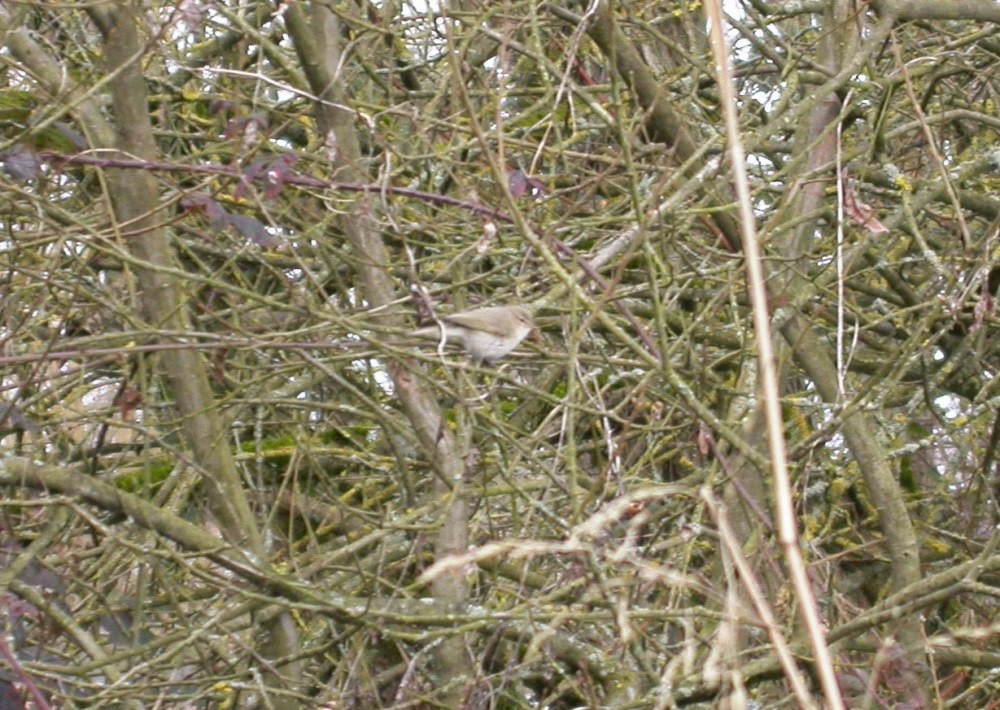I had my first Sand Martins of the year on the 16th, when 10 birds flew north over the lake. Further birds were seen on the 18th, a single, then 6 over north on the 22nd and 7 over again on the 26th.
The first Little Ringed Plover was reported as a brief visitor on the 21st, but I had to wait until the 24th when another bird appeared for just the afternoon - a poor record here, as it was on the far side of the spit:
Today, another expected wader appeared as a first for the year in the form of a Redshank:
The cold weather and northerly winds certainly feels bitter and feels like birds are being held up - I keep looking for Wheatears, but have failed so far. There was a noticeable passage of Meadow Pipits on the 23rd - I counted 187 birds, all through low north. Birds were seen in both a morning and afternoon visit, so were probably moving all day and numbers likely to have been much higher. The largest flock was 40 birds, with several around 20, but a lot of single digit counts. Unfortunately none were grounded and no sight nor sound of Rock or Water with them.
Best bird of the past week goes to a very unexpected Goshawk, only my second on patch and the first for 6 years. I was leaving the site on the 24th when I noticed an unusual looking high flying raptor (not the usual Buzzards or Red Kites). Through bins I could see that it was an accipiter, but it certainly didn't look like a Sparrowhawk and it screamed Gos! I managed to get it in the scope and could see the distinctive wing shape, fairly long with bulging secondaries and a long tail, but thick based and round ended. As it moved away I could see a deep and angular breast line, signifying a robust chest. It was unusually high up I thought, so not sure where it was going, but it was in a steady glide moving NE ish. It didn't need to flap much as it didn't seem to be losing height and I only saw it flap about 4 or 5 times, a nice leisurely but powerful flap, not like the quick flapping of a Sparrowhawk. I eventually lost it behind the tree line. Due to the height and being on its own, it was difficult to judge size, but I got the impression it was probably a male.
Just before seeing the Gos I had been watching another unexpected bird - the continuing Siberian Chiffchaff - I hadn't seen it since the 11th and it hadn't been reported, so I had assumed it had gone. However, in the morning, as I walked down the west path, I was stopped in my tracks by the song of a Sibe Chiff. I quickly found it preening in the sunshine in an ivy covered oak. It was looking quite dishevelled and was obviously in active moult. In fact, the central tail feathers had been dropped and were re-growing, barely longer than the primaries. This gave the tail a distinctly notched look from below. I continued to watch the bird over the next hour or so and it once again favoured the same area I had seen it in a fortnight previously, just beyond the viewpoint. In the mid morning sun, it went into a period of singing and once again, no chiffchaffing, but the distinctive phrasing of a Siberian. This only lasted about 10 minutes and it then went back to silent feeding before disappearing. I wonder how long it will stay? Presumably with its state of moult, it won't want to migrate yet.
Otherwise, it has been usual fare - Snipe numbers still higher than usually seen, though 27 were flushed onto the spit on the 18th; Shelduck have been between 1 and 3 birds most days; 2 Water Rail chasing each other on the east bank on the 17th; Chiffchaff numbers swelled by migrants have reached double figures around the lake and the first Egyptian Goose brood of 8 goslings was seen on the 16th - and to date all are still surviving.
Tree felling and clearing storm blown poplars on the southern bank has closed that pathway for 2 weeks, which is the usual hedge in which I get my first Willow Warblers, so I hope they are quicker than they plan to be!






